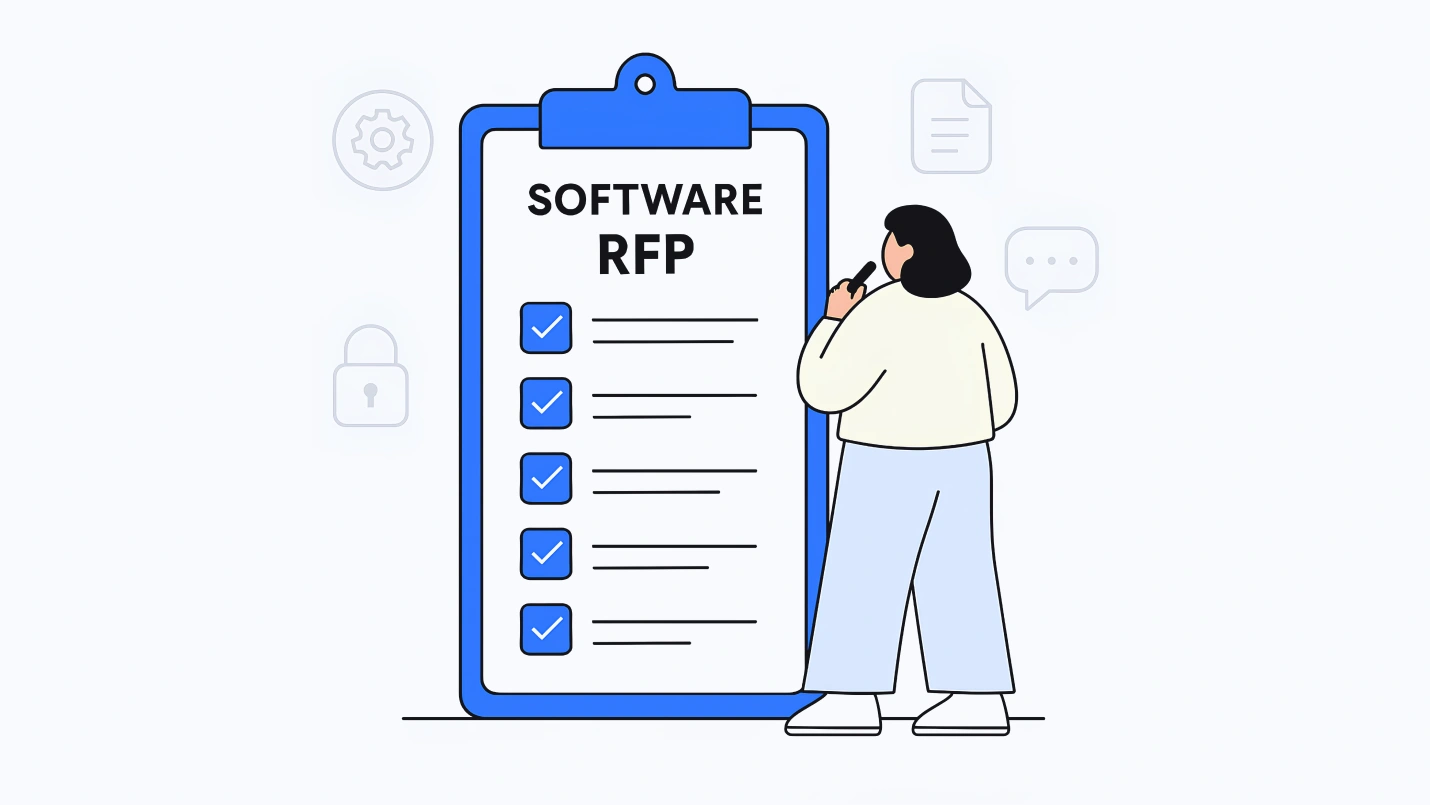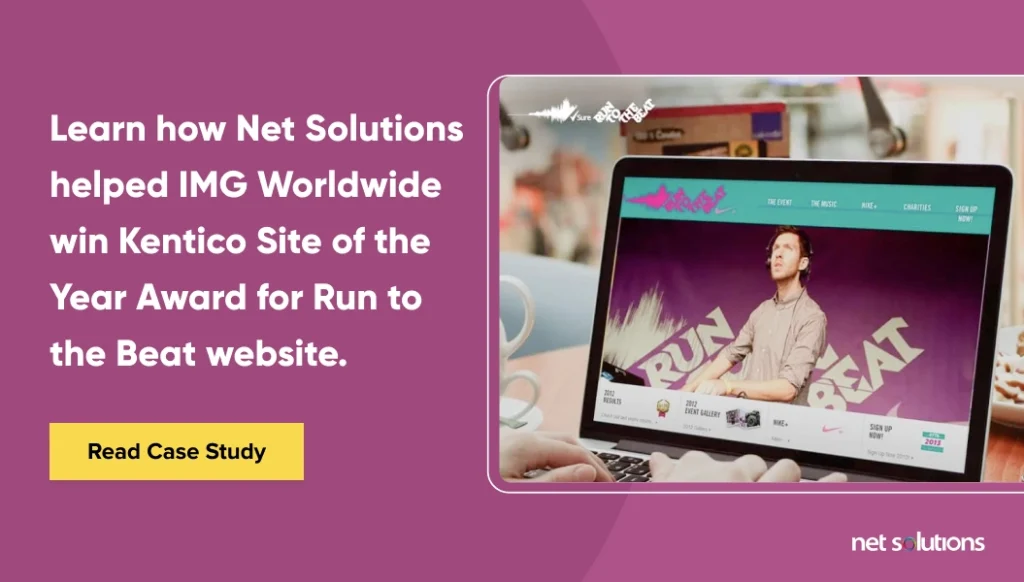Discover how to streamline your software procurement process with an effective RFP template. Learn key elements, evaluation criteria, and best practices.
Outsourcing software development to an off-site vendor can be an effective way to save money, extend the capabilities of your in-house development team, and deliver high-quality software.
A Request for Proposal (RFP) is one tool to find potential vendors and compare expertise, pricing, and other factors that will guide your decision.
This blog post will explore key elements to include in a good RFP, how to design your proposal process, and pitfalls to avoid when writing an RFP—that way; you can find talented software developers for your project.
You can also access our free RFP template here!

What Is an RFP in Software Development?
A Request for Proposal (RFP) is a document companies use to receive proposals from software development companies.
A software development RFP outlines all pertinent information that will allow them to decide, such as project deliverables, timelines, budgets, requirements, and selection criteria. Companies send RFPs to potential outsourcing partners, and a well-written RFP attracts proposals from talented vendors.
RFP vs. RFI vs. RFQ
People who work in procurement toss around a lot of buzzwords: Request for Proposal (RFP), Request for Information (RFI), and Request for Quotation (RFQ). These terms and the associated acronyms are commonly confused, so let’s explore each.
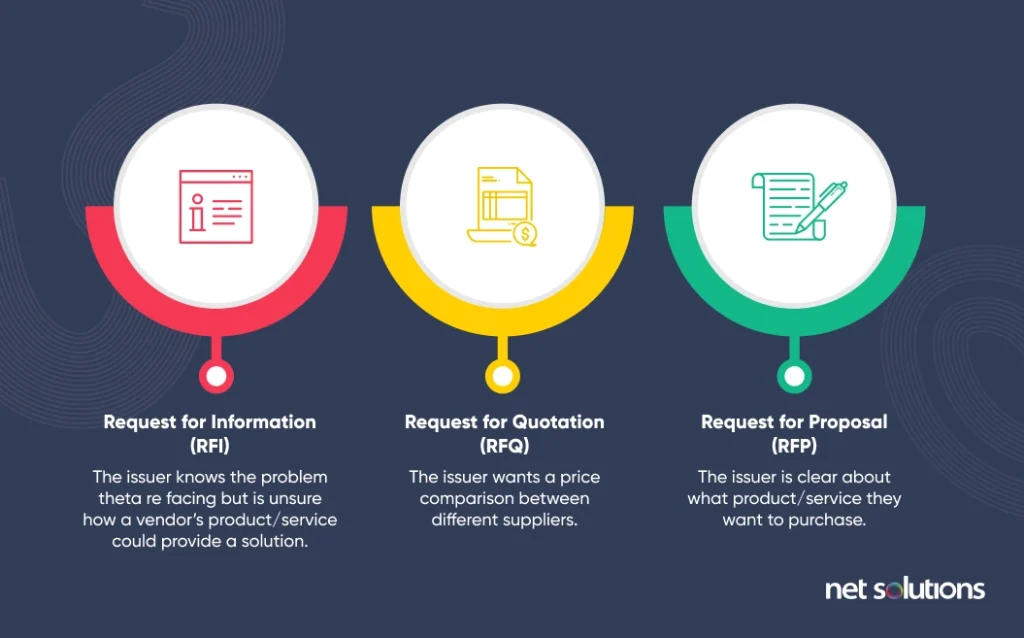
Here’s distinguishing between an RFP, an RFI, and an RFQ.
Request for Proposal (RFP)
When searching for a vendor, procurement professionals often use an RFP when they’re clear on the services or products they plan to purchase.
For example, suppose you wanted to create a piece of software and were already evident on the project deliverables (such as design, development, and Q&A needs). In that case, an RFP is an excellent way to solicit information from prospective vendors.
Request for Information (RFI)
Companies using an RFI typically need clarification on their ultimate project goals or the anticipated software functionality they want to build. Additionally, they may need clarification about how a vendor can serve them.
An RFI comes in handy as a more general tool to request information on a software vendor’s services (or any other vendor, for that matter).
Request for Quotation (RFQ)
When a procurement specialist knows what they want a software development company to create, from technical requirements to business goals, they may need to compare prices. In that case, they can send an RFQ to potential vendors to gain pricing information.
What Are the Benefits of Using a Request for Proposal?
Is it worth it to create an RFP for software development services?
While time-consuming, writing an RFP can help you identify outsourcing partners who can wrap their heads around the software solution you hope to create.
If you have a complex, involved software development project, an RFP can be an integral part of your selection process. Here are some of the benefits that come with creating an RFP.
- Clear communication: Writing an RFP is a great way to communicate software requirements to potential vendors.
- Minimize Risk: When applied to software development, risk can impact your overall success. A solid RFP minimizes the risk of going over budget, hiring an outsourcing partner that can’t deliver what you need, and other potential roadblocks.
- Timeline Accuracy: When vendors know what their stakeholders require, they can estimate how long the development process will take more accurately.
- Conceptualizing the scope of work: Sometimes, we don’t know what we need or want from a software development partner. The Request For Proposal process will help you understand which software development, design, and IT services you need.
- Documentation: Documenting your needs and requirements will give you a clear understanding of your IT project’s needs and make it easier to describe those needs to potential bidders.
- Benchmarking: What will success look like? What functionality are you hoping to achieve with your software product? An RFP helps you identify and communicate benchmarks for success.
As you can see, there are many benefits to creating an RFP. Of course, you and your team must decide whether the work you’ll put into creating an RFP provides an adequate return on your time and effort.
Key Elements of a Software RFP
An effective RFP will provide prospective vendors with key information about your company and project. This will give them a clear understanding of what you do, what you’re trying to accomplish, the target audiences you serve, and other factors.
Including the following 8 key elements will ensure your RFP communicates all the information vendors need to quote an accurate price, timeline, and more.
1. Executive summary
Your executive summary sets the stage for the project, providing potential vendors with a big-picture understanding of your vision.
This isn’t the place to go into great detail about your project requirements. Still, you will identify the problem your software project intends to solve and any background information your IT vendor needs to get a sense of what you’re trying to accomplish.
Every executive summary should include the following:
- A high-level description of your software project and what you’re trying to achieve
- Goals and expectations
2. Company overview
What does your company do as a whole? Briefly describe your target audiences and key stakeholders connected to the development project.
If you’re launching a startup and don’t yet have an established company, describe the company you’re creating and how your software solution will play a role in that company’s mission.
Every company description should include the following:
- Your company’s background
- The problem you solve
- Your target audience
- Your sector, expertise, and key offerings
- A list of your company’s leadership, your project lead, and important stakeholders
3. Project overview and goals
The project overview and goals section will discuss the functional requirements for your software project, along with any details you already understand about design requirements, development needs, Quality Assurance (Q&A) needs, data security, and anything else you’ll need the outsourcing partner to provide.
The level of detail that different companies provide in their RFPs will vary. A company with an in-house development team and a great deal of software development experience will likely have a detailed understanding of workflows, preferred methodologies, etc.
Meanwhile, a startup that consists of one or two entrepreneurs with limited tech know-how will only be able to provide a rough idea of what they’re hoping to achieve.
Honestly? That’s just fine. A good outsourcing partner can help you iron out the details. Just provide as much information about the project as you can.
Every project overview should include the following:
- Goals
- Vision for the app (both short-term and long-term)
- Target audience and user personas (if you’ve created them)
- Customer struggles and how you help them overcome those challenges
- Any risks that might impact your success
- Platforms your software project needs to integrate with (e.g., desktop, mobile, iOs, Android)
- The metrics you will use to evaluate the project’s success
4. Project scope
Vendors will need a clear project scope to set a realistic budget and timeline for your software development project. Also, some firms may need more expertise in specific areas you require. If they know upfront, for example, that you require Agile Scrum project management experience and they don’t have that, they will (hopefully) bow out gracefully.
Every project scope section should include the following:
- All services you require (e.g., design, development, project planning, Q&A)
- Platforms you intend to serve
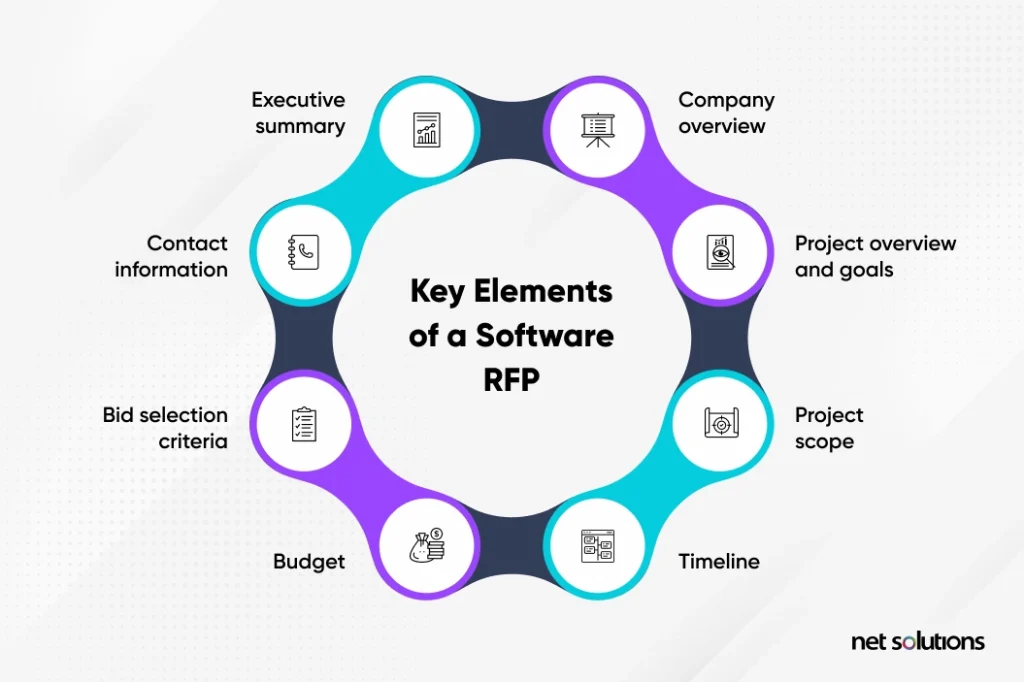
5. Timeline
Do you have a launch date in mind? Are there factors beyond your team’s control that might alter that launch date? Is it flexible?
An experienced software development team will be able to analyze your deliverables and let you know whether your project timeline is realistic based on your requirements.
Key elements to include:
- Anticipated launch date
- Factors that might alter the launch date
- Whether your launch date is flexible
6. Budget
Setting a realistic budget is key to an RFP, especially if you’re price sensitive. Some vendors may be unable to match your budget once they analyze the cost breakdown and labor involved, so it’s good to be as upfront as possible.
While price is always a consideration in business, we don’t recommend using price as your only criterion. Software design and development takes strategy and communication, and dirt-cheap vendors may not have the skills necessary to fulfill your vision.
Outsourcing to countries with a low cost of living is an effective way to balance cost with performance. Just be sure to choose an outsourcing partner that knows what they’re doing, has a proven track record, and speaks your language (literally and figuratively).
Every budget section should include the following:
- Your budget’s range
- Other information, including flexibility in the face of shifting deliverables
7. Bid selection criteria
What are your selection criteria for choosing a vendor? Are you essentially concerned with your budget? Is speed more important to you? Are you looking for a specific area of expertise and experience?
Listing your selection criteria will allow potential vendors to showcase their skills, providing relevant references and case studies.
Every bid and selection criteria section should include the following:
- Required experience in terms of design, programming languages, and other services needed
- Top factors related to your decision (e.g., price, timeline, skillset)
- Anything else that will influence your decision
- The due date for submissions
8. Contact Information
The contact section of your RFP will provide information about how to submit bids and how prospective vendors can follow up with questions. You’ll also want to include information about when you plan to notify prospective vendors that you’ve decided.
Your contact information should include the following:
- How to submit the bid
- Contact information of the person responsible for evaluating the bid
- How vendors can ask questions and follow up on their submissions
How to Create a Software RFP
Creating a software RFP is a process—it’s not just sitting down and writing. It’s important to “plan the plan,” meeting with key stakeholders and determining all the requirements, the scope of work, selection criteria, and how you plan to evaluate potential vendors.
The following four-step process will help you create and issue the RFP and help you develop and plan for evaluating the bids that come through.
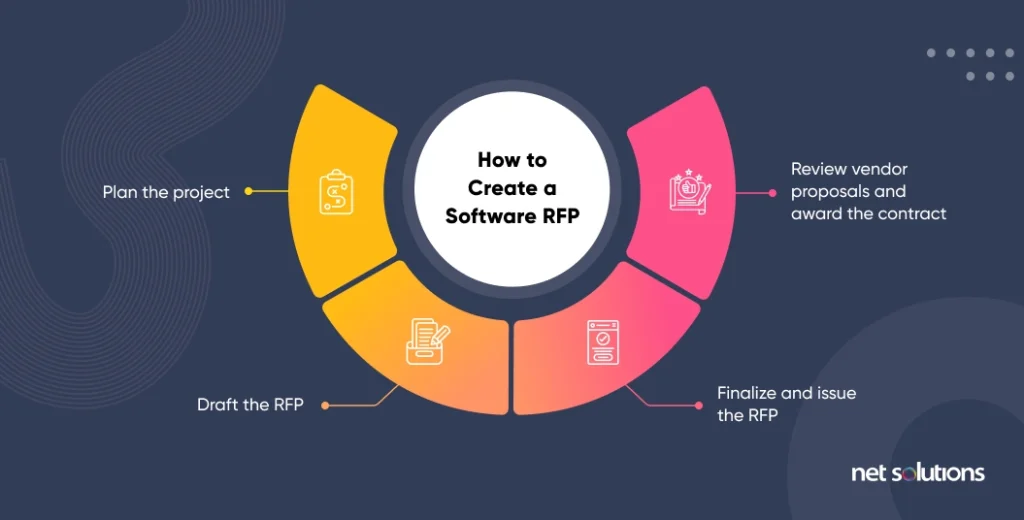
Step 1: Plan the project
Building a project plan is the first step toward creating a software RFP. Your project plan should identify all your product requirements, milestones, timeline, budget, and required services to complete your software.
Again, you may not have all the details—especially if your team doesn’t have a technical background and you rely on an IT service provider to guide you. If that’s the case, provide as much detail as you can. This will help you flesh out your ideas and write a good RFP.
The RFP project planning section should include the following:
- Requirements for the software
- IT outsourcing services needed
- How the software project aligns with your business plan
- Any infrastructure requirements
- A clear project timeline
- A range for your budget
- Project stakeholders
- Your selection criteria and bid scoring process
Step 2: Draft the RFP
When drafting your RFP, describe your business, target market, and what you hope to accomplish with your software product.
What problem will you solve for your target audience? Expressing this in your RFP will help potential partners understand your vision and provide an accurate bid.
Checklist for your portion of the RFP:
- Executive summary
- Company name and information
- Summary of your project
- Project scope
- Budget range
- The anticipated timeframe for each stage in the project
- Deadline for submissions
The RFP should also ask the vendor to provide the following:
- Overview of their services
- Specific services they offer that are relevant to your project
- Case studies outlining work with previous clients
- Methodologies they use and their software development process
- Anything else pertinent to their proposal
Step 3: Finalize and issue the RFP
After your team members have reviewed and finalized the RFP, it’s time to distribute it. You can either identify potential vendors and send the RFP directly to them or use one or more distribution networks.
Steps to finalizing and issuing your RFP:
- Select custom software development teams to send your RFP to
- Explore any RFP distribution networks you might want to use
- Create and follow a system for receiving and filing submissions
- Ensure you have a system in place to answer questions from prospective outsourcing partners
Step 4: Review vendor proposals and award the contract
Once the deadline has passed and you’ve received bids from prospective vendors, it’s time to create a shortlist of your top candidates. Use your scoring system to determine the leading vendors and reach out to your best candidates.
Schedule live interviews, get to know each prospect, and don’t be afraid to ask challenging questions. For a detailed description of the RFP process, look at our ultimate outsourcing checklist.
Steps for reviewing RFP proposals:
- Score proposals
- Choose top candidates
- Conduct interviews
- Hash out the details
- Write and sign agreements
- Inform all shortlisted candidates that you’ve made a decision
Common Mistakes to Avoid in Software RFPs
What makes a good RFP? A clearly written RFP with realistic timelines and budgets, targeting the right vendors, will attract quality suppliers who present accurate bids.
Here are some common mistakes when creating an RFP—and how to avoid them!
Insufficient or unclear requirements
You may know what you want in your head, but unless you clearly outline all the services you require from an outsourcing partner, it will be difficult for them to provide an accurate quote and help you create a final product that serves your goals.
You might need to learn all the steps involved, or all the programming languages required, to build your software product. However, your RFP should clearly describe your required services, such as design, development, project management, Q&A, etc.
Inadequate research on vendors
When selecting vendors for potential proposals, evaluating what they do and whether the services they provide meet your needs is essential.
Net Solutions is a full-service software design and development firm, but many other firms only have limited services. For example, some firms only perform software development, leaving design and Q&A to others.
Sending RFPs to companies that don’t provide all the needed services will result in fewer bids, and it’s not the best use of your time.
Unrealistic timelines or budgets
Software development takes strategy, expertise, time, and money.
While many software development firms in countries like India can accommodate a range of budgets due to their lower cost of living, listing a budget that is too low will likely result in bids from companies that need more expertise to deliver your project successfully.
Experienced software development firms can work efficiently using powerful software development methodologies like Agile Scrum, but nobody can produce amazing software overnight.
Providing a realistic timeline and budget for your project will attract accurate bids from quality IT outsourcing teams.
Lack of clarity in evaluation criteria
Your RFP should list the criteria you value and what you seek in a prospective outsourcing partner. For example, if your primary concern is efficiency and meeting a specific launch date, let vendors know that these items are at the top of your list.
When vendors understand your selection criteria, they can write a proposal that addresses your needs and shape any quotes around what matters most to you.
Poorly written or inconsistent RFP documentation
Clear documentation—regarding your processes, requirements, and goals—is key to receiving quality proposals. A well-written, consistent RFP will not only impact the accuracy of the bids you receive. It will also attract vendors who care about quality.
Remember that the best software development teams often receive more interest in their services than they can handle. A quality RFP lets them know you’re serious about your software development project.
Ignoring legal and contractual considerations
Solid contracts are key to a professional working relationship.
Be sure to specify the types of contractual engagements you’re looking for, whether you plan to establish a short-term contract for a limited set of services or a long-term contract with ongoing support.
At the RFP creation stage, you probably won’t have every detail of what you’re looking for regarding providers and services, and that’s fine. Just be sure to identify your needs and how they fit into the scope of work you’ve identified.
Looking for a Software Development Partner?
Net Solutions has built software for three decades, from design to development to Q&A, managing projects for worldwide organizations like American Golf and IMG.
We also work with startups and midsize organizations, building everything from Minimum Viable Products (MVPs) to full-fledged software products.
Frequently Asked Questions
Here are some tips for writing a clear and concise software RFP:
- Start by clearly defining your needs
- Use clear and concise language
- Be specific about your requirements
- Provide clear instructions
- Set a deadline
There are many factors to consider when evaluating software RFPs. Some of the most important factors include:
- The cost of the software
- The features and functionality of the software
- The vendor’s experience
- The vendor’s support and maintenance offerings
- The vendor’s overall reputation
Some common questions that vendors ask about software RFPs include:
- Can you provide more information about your needs?
- What is your budget for this project?
- What is your timeline for implementation?
- What are your requirements for support and maintenance?
- What are your evaluation criteria?
Once you select a vendor, you must negotiate a software contract. Here are some tips for negotiating a software contract:
- Read the contract carefully
- Be prepared to negotiate
- Get everything in writing


